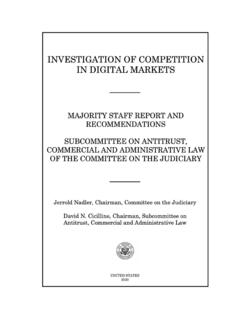Transcription of Semiconductors: U.S. Industry, Global Competition, and ...
1 Semiconductors: Industry, Global competition , and Federal Policy October 26, 2020 Congressional Research Service R46581 Congressional Research Service SUMMARY Semiconductors: Industry, Global competition , and Federal Policy Semiconductors, tiny electronic devices based primarily on silicon or germanium, enable nearly all industrial activities, including systems that undergird technological competitiveness and national security. Many policymakers see strength in semiconductor technology and fabrication as vital to economic and national security interests. The semiconductor industry dominates many parts of the semiconductor supply chain, such as chip design. Semiconductors are also a top export. Semiconductor design and manufacturing is a Global enterprise with materials, design, fabrication, assembly, testing, and packaging operating across national borders.
2 Six or foreign-owned semiconductor companies currently operate 20 fabrication facilities, or fabs, in the United States. In 2019, semiconductor manufacturing directly employed 184,600 workers at an average wage of $166,400. Some semiconductor firms that design and manufacture in the United States also have built fabrication facilities overseas. Similarly, design firms that do not own or operate their own fabrication facilities contract with foreign firms located overseas to manufacture their designs. Much of this overseas capacity is in Taiwan, South Korea, and Japan, and increasingly in China. Some Members of Congress and other policymakers are concerned that only a small share of the world s most advanced semiconductor fabrication production capacity is in the United States. Other have become increasingly concerned about the concentration of production in East Asia and related vulnerability of semiconductor supply chains in the event of a trade dispute or military conflict and other risks such as product tampering and intellectual property theft.
3 Some Members of Congress and other policymakers have expressed concerns about the economic and military implications of a loss of leadership in semiconductors. China s state-led efforts to develop an indigenous vertically integrated semiconductor industry are unprecedented in scope and scale. Many policymakers are concerned that these efforts, if successful, could significantly shift Global semiconductor production and related design and research capabilities to China, undermining and other foreign firms leading positions. Although China s current share of the Global industry is still relatively small and its companies produce mostly low-end chips, China s industrial policies aim to establish Global dominance in semiconductor design and production by 2030. Moreover, Chinese semiconductor competencies could support a range of technology advancements, including military applications.
4 Another issue for policymakers is how to address competing interests: China is an important market for semiconductor firms but and foreign industry are helping to advance China s capabilities. China s government outlays (an estimated $150 billion to date) and its role as a central production point for Global consumer electronics are generating strong incentives and pressures on and foreign firms to focus on China. The Chinese government views access to foreign capabilities in the near term as a key pathway to accelerate China s indigenous development. Also of concern to many are China s state-led efforts to acquire companies and access semiconductor technology through both licit and illicit means; targeted intellectual property (IP) theft; and technology-transfer pressures. Issues before Congress include the appropriate role of government in assisting industry; how best to focus federal financial assistance; the amount of funding each proposed activity would need to accomplish its goals for sustaining semiconductor competitiveness; how to coordinate and integrate federal activities internally and with initiatives of the semiconductor and related industries; and how to address China s ambitious industrial plans, trade practices of concern, and the role of firms in China s emerging semiconductor market.
5 Legislation has been introduced in the 116th Congress to increase federal funding for semiconductor research and development efforts; collaboration between government, industry, and academic partners; and tax credits, grants, and other incentives to spur production. Two bills under consideration are the Creating Helpful Incentives to Produce Semiconductors (CHIPS) for America Act (S. 3933 7178) and the American Foundries Act (AFA) of 2020 (S. 4130). Some of the provisions of these acts have been included in other bills. R46581 October 26, 2020 Michaela D. Platzer Specialist in Industrial Organization and Business John F. Sargent Jr. Specialist in Science and Technology Policy Karen M. Sutter Specialist in Asian Trade and Finance Semiconductors: Industry, Global competition , and Federal Policy Congressional Research Service Contents Introduction.
6 1 Semiconductor Industry Basics .. 2 Semiconductor History and Technological Challenges .. 4 Wafer Size .. 5 Feature Size .. 6 The Global Semiconductor Industry .. 6 Semiconductor Market Segments .. 8 Global Semiconductor Production .. 9 Materials Used for Wafer 10 Design; Fabrication; and Assembly, Testing, and Packaging .. 11 Design .. 12 Fabrication: Facilities (Foundries) .. 14 Fabrication: Equipment and Other Suppliers .. 15 Assembly, Testing, and Packaging .. 17 Key Parts of the Global Semiconductor Supply Chain .. 17 Global Semiconductor Fabrication Capacity .. 18 The Semiconductor Manufacturing 18 Industry R&D Spending .. 19 Semiconductor Manufacturing Jobs .. 19 Semiconductor Production in the United States .. 20 The Global Semiconductor Landscape .. 23 East Asia .. 24 China .. 26 Controls on Semiconductors .. 31 Europe .. 34 The Federal Role in Semiconductors.
7 35 Current Federal R&D Efforts to Develop Potential Technology Alternatives and Supplements to Semiconductors .. 36 National Security Concerns .. 39 DOD Trusted Foundry Program .. 40 Current Semiconductor-Related Legislation .. 43 Concluding Observations .. 44 Figures Figure 1. Semiconductors: An Enabling Technology .. 3 Figure 2. Evolution of Silicon Wafer Size .. 5 Figure 3. Worldwide and Semiconductor Industry Sales .. 7 Figure 4. Global Semiconductor Industry Market Share, by Sales, 2019 .. 7 Figure 5. Typical Global Semiconductor Production Pattern .. 10 Figure 6. Integrated Circuit End-Use Markets and Estimated Growth Rates .. 13 Semiconductors: Industry, Global competition , and Federal Policy Congressional Research Service Figure 7. Exports to China, Share of Exports to the World of Semiconductor Fabrication Equipment .. 16 Figure 8.
8 Revenue for Value Chain Segments by Headquarters Location, 2018 .. 17 Figure 9. Semiconductor Industry Market Share, by Sales, 2019 .. 24 Tables Table 1. Semiconductor Fabrication Capacity .. 18 Table 2. Top 10 States in Semiconductor Manufacturing Employment .. 20 Table 3. 300mm (12-inch) Semiconductor Fabs in the United States, 2019 .. 22 Table 4. Worldwide 300mm Semiconductor Fab Count .. 26 Table 5. Examples of Abandoned or Blocked Chinese Semiconductor Transactions .. 32 Table B-1. The Top 15 Semiconductor Suppliers Worldwide .. 50 Appendixes Appendix A. History of the Federal Role in Semiconductor Development and competition .. 47 Appendix B. Top 15 Semiconductor Suppliers Worldwide .. 50 Appendix C. Semiconductor-Related Legislation in the 116th Congress .. 51 Contacts Author Information .. 53 Semiconductors: Industry, Global competition , and Federal Policy Congressional Research Service 1 Introduction Semiconductors, tiny electronic devices based primarily on silicon or germanium, are a uniquely important enabling technology.
9 They are fundamental to nearly all modern industrial and national security activities, and they are essential building blocks of other emerging technologies, such as artificial intelligence, autonomous systems, 5G communications, and quantum computing. For more than six decades, consistent growth in semiconductor capabilities and performance and concurrent cost reductions have boosted economic output and productivity and enabled new products, services, and industries. Since the immediate post-World War II era, the United States has been a Global leader in the research, development, design, and manufacture of semiconductors. The United States remains a leader in semiconductor research and development (R&D), chip design, and some aspects of semiconductor manufacturing, but a complex mix of both and foreign companies makes up the semiconductor supply chain, including fabrication facilities, or fabs.
10 Nevertheless, in 2019, the United States accounted for 11% of Global semiconductor fabrication capacity, down from 13% in 2015, continuing a long-term decline from around 40% in Many policymakers see the competitiveness of the semiconductor industry, including domestic production of semiconductors and the retention of manufacturing knowledge, human expertise, and hands-on experience, as vital to economic and national security Several factors contribute to congressional concerns about the competitiveness of the semiconductor industry: Sustaining the ability of the industry to continually improve semiconductor performance while decreasing cost through technological innovation. Because semiconductors are integral components in almost all industrial activity and fundamental to several emerging technologies, their performance and price affect multiple sectors and the broader economy.












